

![]()
Potawatomis: Important Men
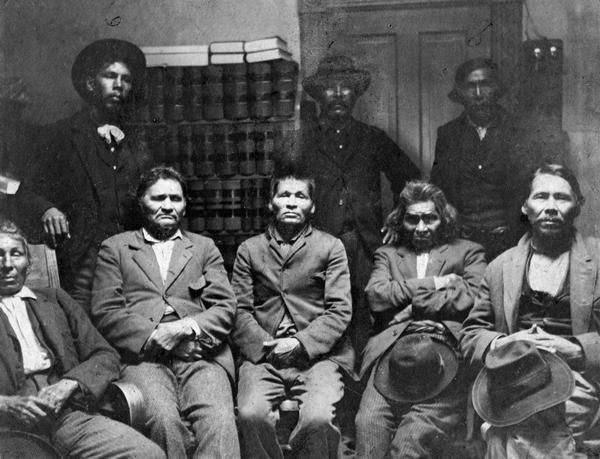
Above: Important Potawatomi Men, hereditary Chief descendants and headmen who were signers of important document, 1890
A group of locally important Potawatomi Indians, apparently photographed in a government or law office at Escanaba, Michigan. Left to right standing are Fred Jones Wanka, Joe Negahnee, and Wis-Ki-Ge-Amatyuk, also known as John Buckshot (Prairie Band Potawatomi, Kansas, principle pipe carrier and ritual leader). Wis-Ki-Ge-Amatyuk, brother of Wahkwabeshkuk/Wahquahboshkuk (Wakwaboshkok, Roily Water), who were sons of Shaumquesteh (Shaum-Num-Teh), who was the son of Chief Sen noge wone. Seated left to right are Joseph Waumegesake (or Wampum, a descendent of the older chief Wampum, born in Manitowoc), Abraham Michicot (or Mishegand, who was born at Mink River in Door County), David Nsa-waw-quet (or Crutch, reportedly the best hunter and trapper in Michigan), Ben Ah-quee-wee (Dr. Ben), and William Keeshik of the Manitowoc band.
Use of any images requires written permission from the staff of the Division of Library-Archives/Wisconsin Historical Society
The Neshnabek people (Hannahville Potawatomi descendants), were roaming the forest looking for a place to live, where they could be left alone to live traditionally. Peter Marksman loaned money to the Potawatomi people to buy homesteads in the area which would later become the Hannahville Reserve. A document was drawn up and prepared by Michael Harris. Respected Chiefs and headmen came together, some traveling far distances, to sign a document August 13, 1883, giving power of attorney to Peter Marksman for the right to speak and negotiate on behalf of the wandering and roaming Potawatomis to help establish a permanent home.

Above: Fred Jones Wanka
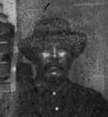
Above: Joe Negahnee or Nen-gah-sum
He is a descendant of Chief Nen-gah-sum (Negahnee). Chief Nen-gah-sum's granddaughter, Tah-pep-bid was second wife of old Chief Ketoose. Old Chief Ketoose died about 6 miles east of Depere in 1869 aged about 110 years old.
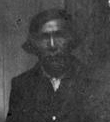
Above: Wis-Ki-Ge-Amatyuk (Potawatomi Holy Man), brother of Wahkwabeshkuk/Wahquahboshkuk (Wakwaboshkok, Roily Water), who were sons of Shaumquesteh (Shaum-Num-Teh), who was the son of Chief Sen noge wone.
Wis-Ki-Ge-Amatyuk (The Smoke That Travels/Powerful Wind) was known as a spiritual interpreter to spirits. A voice and ear in between the physical and spiritual realms (A Messanger).
Wis-Ki-Ge-Amatyuk was also known as John Buckshot (Prairie Band Potawatomi, Kansas, principle pipe carrier and ritual leader)

Above: Joseph Waumegesake (Wandahsega/Waumegesako or Wampum, a descendant of the older chief Wampum, born in Manitowoc).
Chief Wampum was brother to Chief Thunder. Chief Thunder had 4 wives and 35 children.

Above: Abraham Michicot (Meshigaud or Mishegand "Hairy Leg", who was born at Mink River in Door County)
Abraham Michicot was grandson of the old Manitowoc County Chief of that name. Jenny Yellowbird (Sah-Pen-Aiss), sister of Chief Yellowbird, was wife to Abraham Michicot (Mishegand).
Abraham Michicot's father was Ob-Wa-Qua (Thunder Turn Back). Abraham's grandfather was Nay-Ya-Tosh-Ingh. Great grandfather of Chief Mishigaud (Michicot) was Mongezet (Big Foot).
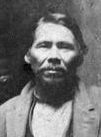
Above: David Nsa-waw-quet (or Crutch, reportedly the best hunter and trapper in Michigan), descendant of Chief Crutch, who was known to have lived on the Sheboygan River.
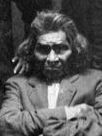
Above: Ben Ah-quee-wee (Qweewe or Dr. Ben), descendant of Chief Qweewe (Ah-quee-wee or Kee-Waw-Nay)
Dr. Ben was son of old Chief Qweewe (Ah-quee-wee or Kee-Waw-Nay) of Sheboygan County. The great village of the Potawatomi was at Little Prairie south of Elk Heart Lake. Chief Qweewe resided on the Sheboygan River and afterwards moved his band to the Manitowoc Forks. On the first Whiskey that came to the Sheboygan River, Chief Qweewe (Ah-quee-wee or Kee-Waw-Nay) became drunk and in the melee that followed had his nose bitten off. He was said to be a good doctor and a big man in stature.
Chief Ah-quee-wee or Ah-kee-way-see (Ah-quee-wee or Kee-Waw-Nay, meaning Old Man Forever) was father of old Chief Ketoose. Old Chief Ketoose's son was named Nen-gau. Nen-gau died at White Fish Bay at age of 30 in about the year 1856. Nen-gau was the father of Chief Simon Kah-quadros. Simon Kah-quadros (Kaquados) is cousin to Joe Wisconsin and Chief Kisheck (Keeshik). Joe Wisconsin's mother was sister of old Chief Ketoose. Joe Wisconsin's father was Kes-kis-hee-shaw and his grandfather was War chief Pa-mam-wee (Chief Pa-mob-a-mee).
Dr. Ben Ah-quee-wee (Qweewe) died in the year 1916, Forest County, Wisconsin. Chief Qweewe (Ah-quee-wee or Kee-Waw-Nay) died in the year 1833.

Above: William Keeshik (Kisheck/Kezhieg/Blue Sky) of the Manitowoc Band is descendant of Chief Keeshik (Kisheck/Kezhieg/Blue Sky)
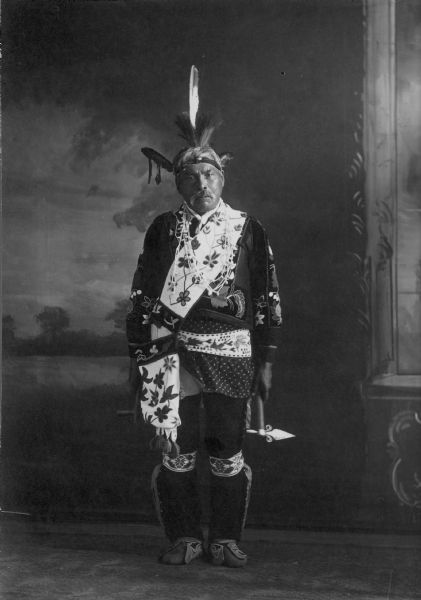
Above: Forest County Potawatomi Chief Simon Kaquados, 1919.
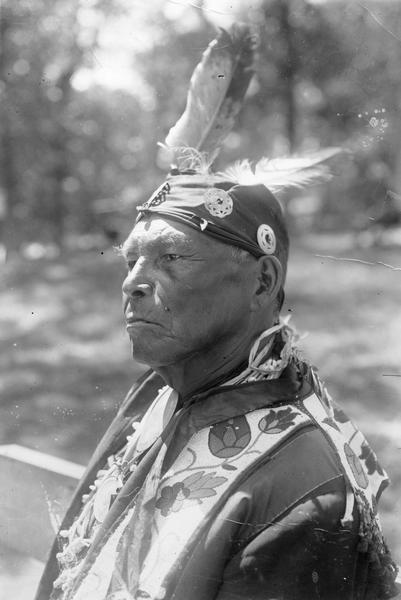
Simon Onanguisse Kahquados (1851-1931) of Forest County, Wisconsin, the last hereditary chief of the Potowatomi.
Above Photo Courtesy of Wisconsin Historical Society
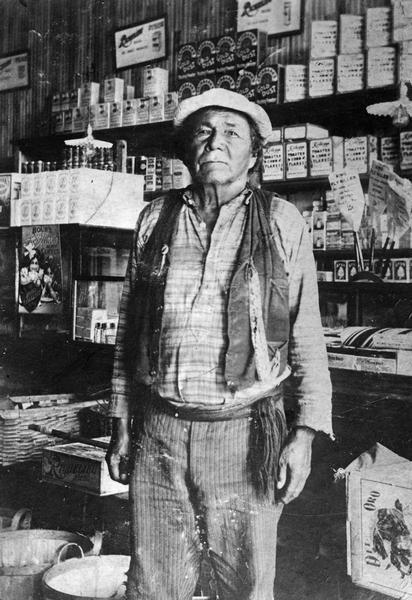
Above: Joe Wisconsin (Sah-gah-gue-je-ma or Lizard), the Potawatomi grandson of Sheboygan War chief Pa-mob-a-mee (Pa-mam-wee). Joe Wisconsin was born at Sheboygan Falls about 1833. At the time of his death he was living in Forest County. The photograph was taken in a store in Goodman, Wisconsin.
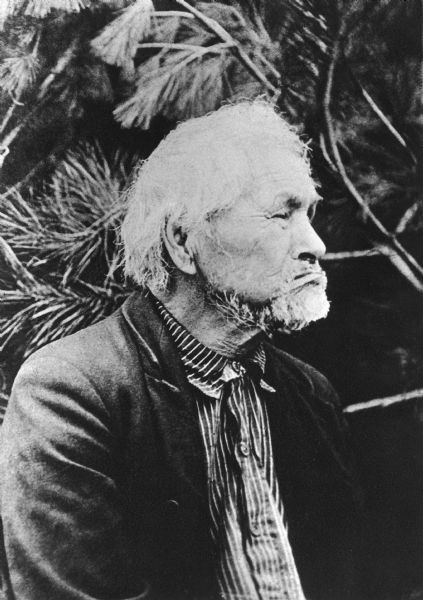
Above: Chief Kee Toose (Ketoose), son of Old Chief Kee Toose.
![]()
Peter Marksman

Above: Peter Marksman
by Cornelia M. Jensen August 4, 1964
Peter Marksman, whose name now appears on the records, became a noteworthy Indian Christian leader. His father was an Indian medicine man who gave his son lessons in the conjurer's art. Ma-diva-given-a-yaush, Shooting at the Mark, was the pagan name of this Indian boy. This, with his Christian name peter, gives us Peter Marksman. He was converted in the log school house of the Soo Indian Mission at Little Rapids, two miles below the falls of St. Mary's River under the preaching of Rev. John Clark about 1833.
Peter Marksman early became an effective minister and at one time he preached on the Prodigal Son and the Indians were moved to tears. "They all, men, women and children, rose up saying we will arise up and embrace Christianity. Monday morning they all brought their images and bad medicines to me. I took them all and did burn them and destroy them before their eyes."
He often knew severe exposure and hardship. In person he was scrupulously neat, tasty in dress, dignified and graceful in manner. In his prime he was eloquent as a preacher. This shining light of early Methodism among the Indians of the Upper Peninsula died at L'Anse on March 28, 1892, aged about 75.
For a short time the Methodists had a Cedar River mission. This we assume was the present Cedar River on the shores of Green Bay, midway between Escanaba and Menominee. In the 1870's when logging operations opened her, this was a predominant Indian settlement. Fishing was good here both in the river and on the Bay.
In 1878 the conference assistance for Indian Missions on the Lake Superior District included $1175 to Cedar River Mission. Grand Island and Cedar River in 1979 reported 69 members and 22 probationers. In 1879 the conference supported an Indian Mission at Hannahville in Northern Menominee County. The redoubtable Peter Marksman opened this work and maintained it for several years. He suffered a deep personal sorrow when his eleven-year-old son died.
In 1835 the US Government had been in the process of moving the Potawatomi Indians to the west. A band of them broke away, worked northward, and between 1865-70 had settled at Harris. Their venerable chief Sah-panaiss, who had led them in their wanderings died in 1882 at the age of 100 years. On August 13, 1883, the Potawatomis gave Peter Marksman the power of attorney, enabling him to represent them in their struggles with the government and the surrounding whites.

Above: Hannah Marksman
The mission and the settlement were named Hannahville in honor of Hannah Marksman. In the early years about one thousand Indians lived here. In 1880 the Hannahville Indian Mission reported 39 members, 11 probationers, 6 baptisms and 50 in the Sunday school. In 1885 it had 35 members and Peter Marksman had received $25 on his $50 salary claim. There continued to be a small Indian Church here under Methodist auspices until 1940 when it was allowed to pass into other hands.
From Escanaba's Lighthouse Library
![]()